

25th September 2025 (10 Topics)
Mains Issues
Context:
The Delhi High Court has recently granted protection to Bollywood celebrities such as Aishwarya Rai Bachchan, Abhishek Bachchan, and Karan Johar against unauthorised use of their images, voices, and AI-generated deepfakes, signalling a wider push for judicial recognition of personality rights in the digital era.
Judicial Recognition of Personality Rights in the Digital Age
Understanding Personality Rights
- Definition: Personality rights protect an individual’s distinctive attributes such as name, image, likeness, voice, and signature from unauthorised commercial exploitation.
- Constitutional Basis: Rooted in Article 21 (Right to Life and Personal Liberty) ensuring dignity, privacy, and autonomy.
- Legal Nature: Not codified in a single statute but derived from common law principles of privacy, defamation, and publicity rights.
Statutory Provisions Relating to Personality Rights
- Copyright Act, 1957
- Section 38A: Exclusive rights of performers.
- Section 38B: Moral rights to prevent distortion or misuse of performance.
- Trade Marks Act, 1999
- Allows registration of names, signatures, catchphrases.
- Celebrities like Amitabh Bachchan, Shah Rukh Khan, Priyanka Chopra have registered their names.
- Passing Off under Section 27 of Trade Marks Act
- Protects unregistered marks and prevents misrepresentation suggesting false endorsement.
Key Judicial Precedents
- Rajagopal v. State of Tamil Nadu (1994): Recognised right to privacy and autonomy over personal identity.
- Rajinikanth Case (2015, Madras HC): Infringement exists if a celebrity is identifiable; proof of deception not necessary.
- Anil Kapoor Case (2023, Delhi HC): Protection from AI misuse; clarified satire, parody, and criticism fall under free speech.
- Jackie Shroff Case (2024, Delhi HC): Injunction against AI chatbots and e-commerce misuse.
- Arijit Singh Case (2024, Bombay HC): Protection against voice cloning; flagged dangers of generative AI.
Personality Rights vs. Free Expression
- Constitutional Safeguard: Article 19(1)(a) ensures free speech.
- Judicial Balancing:
- DM Entertainment v. Baby Gift House (2010) – Cautioned against overexpansion of personality rights at the cost of free expression.
- Digital Collectibles v. GalactusFunware (2023) – Satire, parody, criticism, art, and news reporting fall under legitimate free speech.
Emerging Concerns
- AI and Deepfakes: Rise of generative AI tools misusing celebrity images, voices, and likeness.
- Women and Ordinary Citizens: Increasing vulnerability to deepfakes, revenge pornography, and impersonation.
- Fragmented Legal Framework: Current reliance on judicial precedents leads to inconsistent enforcement.
- Enforcement Challenge: Difficulty in tracking and acting upon each instance of digital misuse.
Way Forward
- Comprehensive Legislation: Enact a dedicated Personality Rights Act clarifying scope, exceptions, and enforcement.
- Clear Exceptions: Explicit protection for satire, parody, academic use, and artistic expression.
- Stronger Technological Safeguards: Collaboration with digital platforms to detect and take down impersonation content swiftly.
- Gender-Sensitive Framework: Address disproportionate impact on women from deepfakes and online impersonation.
- Awareness and Registration: Encourage individuals, especially public figures, to register personality attributes under IP laws.
|
PYQ: “The expansion of the Right to Privacy has implications for digital governance in India.” Discuss. (2021) |


Mains Issues
Context:
The Ministry of Panchayati Raj launched multiple digital initiatives, including SabhaSaar (AI-based meeting summariser), and reported significant progress under the SVAMITVA Scheme and eGramSwaraj Portal.
Digital Governance at the Grassroots
Key Initiatives in Digital Transformation
- SabhaSaar: AI for Governance
- Objective: Provides real-time structured summaries of Gram Sabha meetings.
- Features: Linked with Bhashini (National Language Translation Mission) supporting 14 Indian languages.
- Impact: Reduces manual delays in documentation, enhances transparency, and allows Panchayat officials to focus on service delivery.
- SVAMITVA Scheme: Property Rights and Mapping
- Achievements: As of August 2025, 63 crore property cards issued in 1.73 lakh villages; drone survey completed in 3.23 lakh villages.
- Significance: Provides legal ownership, facilitates loans, improves tax collection, and reduces land disputes.
- Global Model:Recognised as a citizen-centric governance model using drones and digital mapping.
- BharatNet: Digital Backbone of Villages
- Coverage: Over 26 lakh villages (out of 6.44 lakh) connected to internet through 3G/4G by June 2025.
- Implementation: Provides FTTH connections (13 lakh commissioned) enabling e-education, e-health, and e-governance.
- Relevance: Core infrastructure for Digital India and Atmanirbhar Bharat vision.
Integrated Digital Platforms for Panchayats
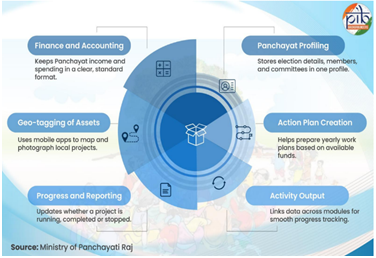
- eGramSwaraj Portal
- Functions: Brings together planning, accounting, progress monitoring, and online payments.
- Achievements FY 2024-25:54 lakh GPs uploaded GPDPs; 2.41 lakh GPs completed 15th FC online transactions.
- Impact: Promotes transparency, decentralised planning, and accountability.
- Meri Panchayat App
- Features: Provides citizens access to Panchayat budgets, plans, weather forecasts, and grievance redressal.
- Reach: Serves 2.65 lakh GPs, 25 lakh elected representatives, and nearly 95 crore rural residents.
- Contribution: Strengthens SDGs by promoting digital inclusion and citizen empowerment.
- Panchayat NIRNAY Portal
- Purpose: Monitors Gram Sabha meetings, notifies agendas, and ensures wider citizen participation.
- Impact: Replaces paper-based processes with transparent, real-time records.
- Gram Manchitra GIS Application
- Utility: Uses spatial technology for developmental planning, asset mapping, and project tracking.
- Advantage: Provides data-driven decision-making capacity at village level.
Recognition and Rewards
- National Awards for e-Governance (2025): Introduced grassroots category for Panchayats.
- Winners: Rohini GP (Maharashtra – Gold), West Majlishpur GP (Tripura – Silver), Jury awards to Palsana GP (Gujarat) and Suakati GP (Odisha).
- Incentives: ?10 lakh for Gold, ?5 lakh for Silver for further service delivery improvements.
Strengths of Digital Panchayats
- Enhances transparency, accountability, and citizen participation.
- Reduces dependency on intermediaries through direct digital access.
- Integrates planning, monitoring, and service delivery on one platform.
- Supports the SDG 16 (Peace, Justice, and Strong Institutions) and SDG 9 (Industry, Innovation, and Infrastructure).
Challenges in Implementation
- Digital divide persists in remote and tribal areas despite BharatNet expansion.
- Capacity gaps among Panchayat officials in using advanced digital tools.
- Data security, privacy, and digital literacy of rural citizens remain concerns.
- Resistance to change from traditional manual processes.
Way Forward
- Strengthen last-mile connectivity and ensure reliable broadband under BharatNet.
- Expand capacity-building programmes for Panchayat representatives and staff.
- Enforce strong cybersecurity protocols for citizen data protection.
- Promote inclusive participation by integrating women, youth, and marginalised groups in digital governance.
- Periodic impact assessments to align platforms with local needs and global benchmarks.


Mains Issues
Context:
World Food India (WFI) 2025, organized by the Ministry of Food Processing Industries, will be held from 25–28 September 2025 at Bharat Mandapam, New Delhi, with participation from 90+ countries and 2,000+ exhibitors, showcasing India as a Global Food Hub.
India’s Food Processing at Global Crossroads
Evolution and Significance of WFI
- Inception and Growth: Launched in 2017, WFI has grown into a premier platform for global stakeholders to engage with India’s food processing sector.
- Global Participation: The 2025 edition is the largest so far, with New Zealand and Saudi Arabia as Partner Countries, and Japan, UAE, Vietnam, and Russia as Focus Countries.
- Strategic Positioning: WFI positions India not only as a market but also as a trusted partner in global food security and sustainability.
India’s Strengths in Food Sector
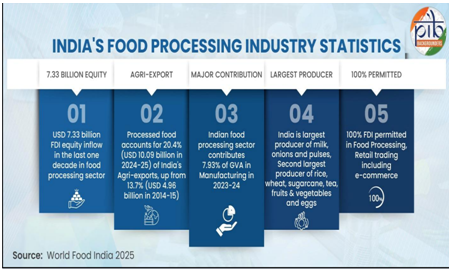
- Agricultural Base: India is the largest producer of milk, onions, pulses, and the second-largest producer of rice, wheat, sugarcane, tea, fruits, vegetables, and eggs.
- Economic Contribution: The food processing sector contributes significantly to GDP, employment, and exports; processed food accounted for 20.4% of agri-exports in 2024–25.
- Employment Impact: About 23 million workers in registered units and 4.68 million in the unregistered sector are engaged in food processing.
Government Initiatives and Policies
Infrastructure Development: Establishment of 24 Mega Food Parks, 22 agro-processing clusters, 289 cold chain projects, and 305 processing and preservation units.
- Policy Reforms: 100% FDI in food processing, NABARD’s ?2,000 crore fund for food parks, and ease-of-doing-business reforms through online schemes.
- Schemes:
- PMKSY (infrastructure, supply chains).
- PMFME Scheme (support to micro-enterprises, SHGs).
- PLI Scheme for Food Processing (?10,900 crore outlay).
- PLI Scheme for Millets-based Products (RTE/RTC millet products).
Strategic Objectives of WFI 2025
- Showcasing India as Global Food Hub: Bridging agriculture, technology, processing, and exports.
- Forging Partnerships: B2B, B2G, and G2G meetings for trade and investment.
- Knowledge Exchange: Global Food Regulators Summit (FSSAI) and India International Seafood Show (SEAI) to harmonize food standards and expand seafood exports.
- Innovation and Start-ups: Startup Grand Challenge, Digital Showcase, and specialized pavilions for HoReCa, alcoholic beverages, and pet food.
Challenges and Concerns
- Post-Harvest Losses: Despite progress, wastage in perishable produce remains high.
- Small-Scale Sector Constraints: Informal and unregistered units face limited credit access and technology adoption barriers.
- Global Competition: India must align food safety and quality standards with international norms to remain competitive.
Way Forward
- Strengthen Cold Chain and Logistics: Expand integrated cold chains and smart supply systems to minimize post-harvest losses.
- Boost R&D and Technology Adoption: Invest in innovation for value-added products, fortified foods, and sustainable packaging.
- Enhance Global Branding: Promote Indian food products such as millets, spices, and seafood under “Make in India” branding.
- Inclusive Growth: Strengthen support for MSMEs, SHGs, and farmers’ producer organizations to enhance rural prosperity.
- Sustainability Focus: Promote climate-smart agriculture and nutrition-sensitive food products in line with Vision 2047.

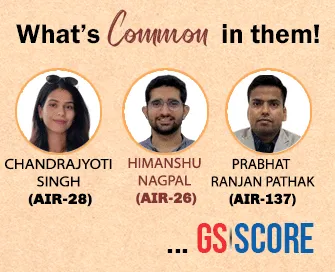
Prelims Articles
Context:
Vice President Shri CP Radhakrishnan commences First State Visit with Prayers at Kanak Durga Temple
Religious and Cultural Significance
- Swayambhu Shrine: The temple is believed to be self-manifested (Swayambhu), enhancing its sanctity.
- Presiding Deity of Vijayawada: Kanaka Durga is revered as the Goddess of power, prosperity, and benevolence, attracting lakhs of devotees annually.
- Unique Worship Tradition: Only temple in the world where the main deity is decorated in nine different forms (Saraswati, Mahalakshmi, Bala Tripura Sundari, Rajarajeswari, Mahishasuramardini, Durga Devi, Annapurna Devi, Gayatri, Lalitha Tripura Sundari) during Navaratri.
- Deity Placement: Durga positioned on the right side of Malleswara Swamy (unlike traditional left-side positioning), symbolizing Shakti’s predominance.
- Festivals: Major celebrations include Navaratri and AshadamSareUtsavalu.
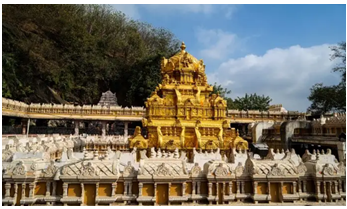
Mythological and Historical Associations
- Arjuna’s Penance:Indrakeeladri Hills are associated with Arjuna praying to Lord Shiva, linking the site to Mahabharata traditions.
- Adi Shankaracharya’s Contribution: Installed Sri Chakra and institutionalized Vedic mode of worship, replacing animal sacrifice.
- Legends of River Krishna:
- Indrakeeladri yielded to allow Krishna river passage but was partly carried downstream, forming Thelukonda (floating hillrock).
- Another legend speaks of Kanaka Durga borrowing Krishna’s nose-stud, with Krishna vowing to reclaim it at the end of Kaliyuga.
Geographical Significance
- Location: Situated on Indrakeeladri Hill, overlooking the River Krishna in Vijayawada, Andhra Pradesh.
- Spiritual Geography: The temple combines natural landscape (hill + river) with spiritual narratives, symbolizing divine-human-nature harmony.
Socio-Economic Importance
- Pilgrimage Hub: Attracts lakhs of devotees during Navaratri, boosting religious tourism and local economy in Vijayawada.
- Cultural Identity: Acts as a focal point for Andhra Pradesh’s devotional traditions and regional festivals.
Bhakti and Temple Traditions
- Living Bhakti Tradition: Strong association with Shakti worship and continuation of Vedic rituals.
- Processions and Offerings: “AshadamSare” tradition involves devotees offering sarees to Goddess, symbolizing devotion and continuity of folk traditions.

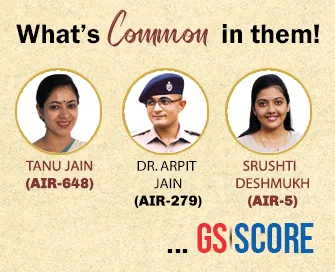
Prelims Articles
Context:
Typhoon Ragasa struck southern China after battering Hong Kong and Taiwan, leaving at least 15 people dead and causing widespread infrastructural damage.
Nature and Characteristics of Typhoon Ragasa
- Landfall Location: Hailing Island, Yangjiang City, Guangdong Province, China.
- Timing: September 24, around 5 p.m. (0900 GMT).
- Wind Speed: Maximum sustained winds of approximately 145 kmph at landfall.
- Destruction Caused: Winds ripped signboards, uprooted trees, and damaged fences and infrastructure.
Regional Impact
- Taiwan: Reported at least 15 fatalities due to heavy rains, landslides, and storm-related incidents.
- Hong Kong: Severe weather disruption, flooding in low-lying areas, and transportation paralysis.
- Southern China: Severe infrastructural damages, uprooting of trees, and electricity disruptions in Yangjiang.
Broader Implications of Increasing Typhoons
- Climatic Connection: Rising sea-surface temperatures in the Pacific Ocean are intensifying typhoons.
- Humanitarian Concern: Death tolls, displacement, and economic losses remain severe in densely populated regions.
- Urban Vulnerability: Megacities like Hong Kong and Guangzhou face higher risks due to high-rise infrastructure and dense populations.
|
Typhoons and Cyclones Definition of Typhoon:
Cyclone Circulation Patterns:
Types of Cyclones and Regional Terminology:
|

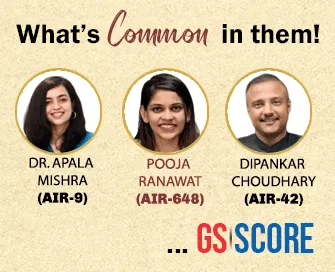
Prelims Articles
Context:
The Election Commission has introduced an Aadhaar-based e-sign verification feature on its ECINet portal and app to prevent fraudulent addition and deletion of names in electoral rolls.
New ECINet e-Sign Feature
- Integration of Services: ECINet consolidates over 40 earlier EC apps and web platforms into a single system.
- Forms Covered: The new Aadhaar-based verification applies to Form 6 (new registration), Form 7 (deletion), and Form 8 (corrections).
- Verification Mechanism: Applicants must authenticate their Aadhaar via OTP sent to their Aadhaar-linked mobile number, with consent for authentication before submission.
Rationale for Reform
- Addressing Fraudulent Practices: Investigations (e.g., Karnataka CID probe into Aland constituency) exposed systematic deletion of nearly 6,000 voters’ names through forged Form 7.
- Political Concerns: Allegations of fraudulent deletions (Aland, Karnataka) and additions (Rajura, Maharashtra) highlight the vulnerability of electoral rolls.
- Enhancing Trust: Strengthening procedural checks is aimed at preventing manipulation and maintaining the credibility of electoral processes.

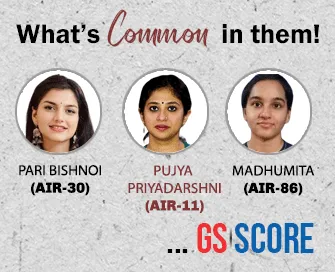
Prelims Articles
Context:
The growing adoption of Artificial Intelligence (AI) globally and in India is significantly increasing energy demand, raising concerns about data centres’ impact on power grids.
AI and Rising Energy Demand
- Global Perspective:
- International Energy Agency (IEA) 2024 report projects AI-driven data centre energy demand to more than double by 2030 (~945 TWh).
- McKinsey:Global data centre capacity demand may rise 19–22% per year (2023–2030), from 60 GW to 171–219 GW.
- India-Specific:
- Data centre demand projected to rise 2 GW (2024) ? 4.5 GW (2030) due to AI and digital adoption.
- Key hubs:Mumbai (41%), Chennai (23%), NCR (14%).
- AI-driven data centres may consume additional 40–50 TWh/year by 2030.
- Energy Footprint Comparison:
- Current:1–2% of global power; projected: 3–4% by 2030.
- For perspective: Steel industry consumes ~7% of total energy.
Challenges and Pressures
- Electricity Demand: High computational requirements of AI intensify grid pressure.
- Water Usage: Cooling servers in data centres increases freshwater demand.
- Carbon Emissions: Despite renewable energy integration, AI-related energy use may increase emissions.
- Cybersecurity Risks: AI increases sophistication of cyberattacks on energy utilities, impacting energy security.
Opportunities for AI in Energy Management
- Efficiency Gains:
- AI optimisesenergy delivery, utilisation, and resource management.
- Predictive load management, demand forecasting, and renewable integration.
- Smart Real Estate:
- AI-enabled HVAC optimisation, smart lighting, building automation reduces energy use by up to 25%.
- Green certifications (GRIHA, LEED) encourage AI-driven monitoring.
- Renewables Integration:
- AI aids hybrid solar-wind-battery plants, ensuring 24/7 renewable energy availability.
- Real-time load forecasting reduces outages and grid stress (examples: Tata Power ReNew, BESCOM, Uttar Pradesh smart meters).


Editorials
Context:
At 80, the UN faces questions on its effectiveness as global conflicts, resource constraints, and shifting geopolitics challenge its core mission.
UN’s Current Challenges
- Erosion of UN Credibility: The UN struggles with relevance due to inability to resolve conflicts like Ukraine, Sudan, and Haiti despite decades of peacekeeping promises.
- Resource Constraints: Member states’ reduced funding and shifting priorities, especially from the U.S., undermine the UN’s operational capacity.
- Geopolitical Polarisation: Rising influence of powers like China, and contestations over multilateralism, challenge the UN’s unity and effectiveness.
Shifting Priorities and Structural Issues
- Washington’s Realignment: The U.S. prioritises its own security and strategic interests, often bypassing UN mechanisms.
- Fragmentation of Multilateralism: Divergent agendas among member states have weakened the UN’s role as a universal platform for conflict resolution.
- Underfunding of Core Mandates: Peacekeeping, climate action, and humanitarian assistance suffer from budget cuts and a lack of coordinated resources.
The Way Forward
- Need for UN Reforms: Strengthening governance, accountability, and resource allocation is critical to restoring the UN’s credibility.
- Global South’s Role: Developing countries must unite to push for meaningful reforms and equitable decision-making within the UN system.
- Leadership and Commitment: The selection of a new UN Secretary-General and collective political will will determine the UN’s future relevance.
Practice Question:
“Multilateralism is at a crossroads in the 21st century. Critically examine the challenges confronting the United Nations and discuss the reforms required to restore its effectiveness and relevance in global governance.” (250 words)


Editorials
Context:
India-U.S. relations are witnessing mixed signals, with renewed high-level engagements alongside fresh tensions over trade, visas, and strategic issues.
Diplomatic Engagements
- Resumption of Talks: Trade negotiations have restarted in Delhi and Washington, focusing on contentious issues like agriculture, dairy, and GM foods.
- High-Level Meetings:S. Secretary of State Marco Rubio met EAM S. Jaishankar in New York; a U.S. Congressional delegation also visited India.
- Prospective Summits: Discussions are underway about a Modi-Trump meeting at the ASEAN Summit and the possibility of Trump’s visit to India for the Quad Summit.
Trade and Strategic Areas
- Positive Momentum: Both sides have expressed willingness to sustain dialogue on trade, defence, energy, pharmaceuticals, and critical minerals.
- Investment Prospects: Indian investments and purchases of U.S. military hardware and energy are expected to facilitate talks on a free trade agreement.
- Negotiating Platform: Commerce Minister Piyush Goyal is leading discussions to bridge differences and build trust on market access issues.
Emerging Frictions
- Visa Fee Shock: The Trump administration imposed a $100,000 fee on H-1B visas, severely affecting India’s IT sector.
- Chabahar Setback: The U.S. revoked India’s sanctions waiver for operations at Iran’s Chabahar port, undermining India’s regional connectivity plans.
- Strategic Strain:S. pressure on India to cut Russian oil imports and its mediation narrative on India-Pakistan relations create unease in New Delhi.
Practice Question
“India-U.S. relations are increasingly characterized by cooperation in trade and strategic domains but are simultaneously marred by unpredictability and friction. Critically analyze this statement in the context of recent developments.” (250 words)

Editorials
Context:
Rising non-communicable diseases (NCDs), especially hypertension and obesity, have renewed focus on India’s high dietary salt consumption, which exceeds WHO recommendations.
Current Situation
- Excessive Intake: Indian adults consume 8–11 grams of salt daily, nearly double the WHO limit of 5–6 grams.
- Hidden Sources: Nearly three-fourths of salt comes from home-cooked food such as pickles and papads, while packaged and restaurant foods add “invisible salt.”
- Health Impact: High salt consumption is directly linked to hypertension affecting 28.1% of adults, raising risks of cardiovascular diseases.
Challenges in Salt Reduction
- Low Public Attention: Current discourse emphasizes sugar and fat through boards, while salt receives limited advocacy.
- Cultural Myths: Rock salt, black salt, and Himalayan pink salt are wrongly perceived as healthier, though all contain harmful sodium.
- Behavioural Patterns: A salty taste is acquired; early exposure in children normalizes high salt intake, worsening long-term risks.
Policy and Strategic Responses
- WHO Recommendations: Salt reduction is called a “best buy” intervention, with a $12 return for every $1 invested.
- Public Food Programmes: Schools, Anganwadis, and hospitals must regulate salt in meals through procurement norms, cook training, and standards.
- Reform Measures: India needs front-of-pack salt warning labels, HFSS boards, community initiatives, and integration of salt reduction into national NCD programmes.
Practice Question
“India faces a silent but serious health crisis due to excess salt consumption. Critically examine the causes, consequences, and policy interventions required to address this challenge in light of the WHO recommendations and India’s NCD strategy.” (250 words)



